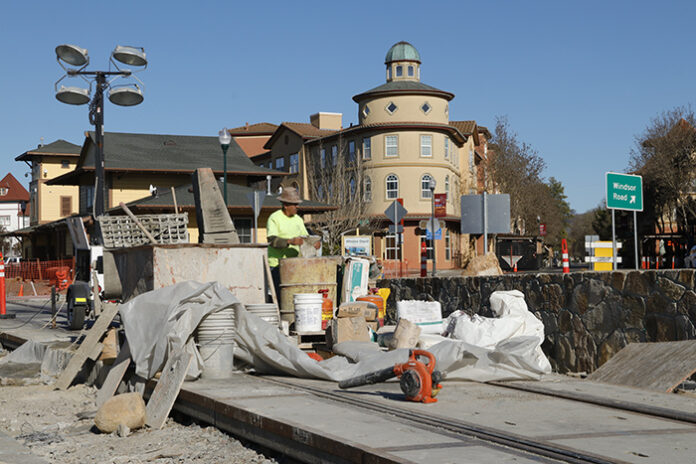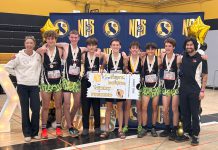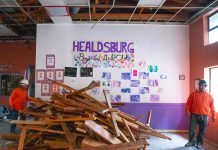
Sonoma Marin Area Transit Service (SMART) moving forward toward its long-held goal of providing commuter rail service from the San Francisco Bay to northern Sonoma County, as promised since 2002.
One of the knottiest challenges it has faced is the rail’s northward expansion, including service to Healdsburg and beyond. A recent court ruling and other positive financial signs, however, suggest the ambitious transit link may be headed for success sooner rather than later, or never.
There are indications that the financial constraints on the ambitious regional rail service are loosening. The biggest roadblock was a lawsuit brought by the Howard Jarvis Taxpayers Association.
That legal action prevented the state from spending money it had already collected on regional transportation improvements. The association said the regional measure passed in 2017 should have required two-thirds vote to be valid; it only received a 55% majority.
Making it apparent which side of the lawsuit he stood on, state Sen. Mike McGuire said in a Jan. 30 email message, “The California Supreme Court recently issued a unanimous decision to toss out a ridiculous lawsuit that attempted to silence the voice of Bay Area voters on Regional Measure 3.” McGuire’s Senate District 2 extends from San Francisco Bay to the Oregon border along the coast, and fully includes SMART’s current service area.
The State Supreme Court voted unanimously to dismiss a lawsuit from the Taxpayers Association that challenged the voter-approved Regional Measure 3 (RM3). That 2017 ballot measure was designed to help solve Bay Area-wide congestion problems by using BART bridge toll increases to fund construction of area highway and transit improvements. Voters in eight Bay Area counties, including Sonoma, voted in the June 2018 primary election.
While the measure was in litigation, BART raised their bridge tolls anyway, to $7 last year, with another dollar hike scheduled for 2025. Revenue the toll hike raised was placed into escrow, pending the outcome of the suit. The actual distribution of the accumulated $4.45 billion is expected to begin soon, now that the court has rejected the appeal.
“The funding has been delayed due to litigation up until the Supreme Court’s recent ruling, which was a big dose of common sense,” McGuire’s message said.
The money can be used not only for the long-awaited commuter rail into north county, but several other key North Bay transportation objectives as well. These include improvements to Highway 37 drainage in the Novato area, permanent improvements at the Narrows between Marin and Sonoma county line, and what McGuire called “the nightmare at the Highway 101/580 interchange in Marin.”
SMART’s Outlook
“The State Supreme Court’s ruling on RM3 is fantastic news for SMART, for mobility, for congestion relief and for protecting our climate,” said SMART board chair David Rabbitt. “The funding not only secures our ability to provide passenger rail service to Windsor, but also positions the agency to go further north to Healdsburg and Cloverdale.”
The promised release of funds is another piece of good news for the rail and pathway project, established by state legislature in 2002, which only became partially operational in mid-2017. Currently, SMART has regular service along 45 miles of track from the Sonoma County Airport to the ferry terminal in Larkspur, characterized as Phase One of the SMART rail system.
Phase Two would extend the commuter rail system another 35 miles north to Cloverdale, with stations in Windsor and Healdsburg. The entire project was penciled out to cost $450 million in 2008; the latest estimate, including the northward expansion, would come to $944 million.
A significant portion of SMART’s operating expenses comes from a quarter-cent sales tax in Marin and Sonoma counties, approved in 2008 as Measure Q, but that tax expires at the end of 2028. An effort to extend that expiration date for 30 years, Measure I, failed to win adequate support in March 2020. SMART is expected to put a similar extension on the ballot in the next two years.
All Aboard for Windsor
The rail transit agency is awaiting announcement of four grants to support the Windsor and Healdsburg extensions, totaling over $140 million. If these grant applications are successful, when combined with the newly-released RM3 funding, SMART should be able to complete the extension to Windsor in fiscal year 2025-26 and to Healdsburg only a year later.
When asked if Windsor was ready for the arrival of SMART in three or four years, Debora Fudge answered, “We’re thinking like two (years). We started construction to Windsor maybe three years ago; we’ve got it 30% constructed already.” The longtime Windsor City Council member and mayor has served on the SMART board of directors for 18 years, since 2005, as representative of the Mayors and Councilmembers Association of Sonoma County.
Even though the sizable RM3 funds were unavailable, SMART used the money they had on hand to begin “strategic construction,” as Fudge said. “We purchased everything we needed to purchase—it’s all stored in Windsor right now, all the track, all the materials we needed—because we knew we didn’t want to have a lag time purchasing materials.”
They also took up the old track to prepare for new, and did all the creek mitigation and construction they could execute with available funds. “Strategically, as soon as we get the money, which shouldn’t be too long, we go back and re-mobilize the contractor and move fairly quickly” toward construction, said Fudge.
“Construction takes about 18 months from the time construction starts, and we don’t have that start date yet,” Fudge continued.
If all of the money in the queue comes through, Fudge estimated the line could arrive in Healdsburg in fiscal year 2026. She pointed to the $1.8 million from federal infrastructure funds Rep. Jarod Huffman negotiated in December, for designing the Healdsburg extension.
Fudge also noted that one of the four pending grants totaling $88.5 million in Transit and Intercity Rail Program funds may be announced shortly. An additional $58 million awaits approval in mid-2023.
“We’re hoping to tie Windsor and Healdsburg together,” said Fudge, referring to strategic planning and organization. “We’re already inching past Windsor, even though we’re not in construction yet. I think there’s more of a chance now for Healdsburg sooner than later than there was a couple years ago.”









The only thing Smart about the Smart Train is the money the manager is making= $335,104.00 $0.00 $29,230.00 $364,334.00 $81,294.00 $445,628.00
WOW!!!! A train that goes now were. Plus you have to pay for parking. This is outrages. No one should be earning this kind of salary.
The only thing Smart about the Smart Train is the money the manager is making= $335,104.00 $0.00 $29,230.00 $364,334.00 $81,294.00 $445,628.00
WOW!!!! A train that goes no were. Plus you have to pay for parking. This is outrages. No one should be earning this kind of salary.
I live in Healdsburg along with 11,000-plus other people, so I can verify that it’s “somewhere.” So is San Francisco, one of the world’s great cities, and once you get to the Larkspur Ferry you can get to SF. Reducing congestion on 101; reducing pollution from cars; enabling people who can’t drive to travel: these are all very, very good things. And cars not being driven up and down the freeway will last longer, together with their tires, more than cancelling out the money spent on railway fares.
Roll on, SMART!
And once you can get to SF from the Ferry, you can take BART to SFO for $10.00, enabling a future someone to walk out their door in Cloverdale and end up in Macedonia, or wherever. Relatively cheap and stress free.
Just do it! Cloverdale has had a maintenance building and a station building for ages -over 20 years. The present route, as one comment says is a train to nowhere change it to a train from Cloverdale to the ferry. Don’t you see the future of Electric cars sitting waiting for charging more stations or running out of JUICE during the Rush Hours, the trains are going to be necessary. Have you ever seen the rush hour traffic all the way to Ukiah and Willets daily. Open your future eyes! This isn’t a Billion dollar Governors legacy dream of a Super Train after all. The point of too high cost for cushion seated administrative jobs should be taken to heart and revised to voters acceptability. Lastly do not Over Price your product! Quantity is your goal, I would hope. Then sell your Non-Profit charged cost compared to all car costs. Car, tires, gasoline, oil. Insurance per mile
This is very good news. The Howard Jarvis Taxpayers Association continues to perpetuate a fraud that was started by a crazy man back in the 1980’s (Howard Jarvis) who told Californians that you can get something for free. The reality is we have to pay for the services we want from our government. This includes schools, infrastructure, airports, trains, hospitals, state parks, ports and so many other things that bring quality to our lives.
It is time to put to bed this nonsense. We need to move forward and build a carbon-neutral, 21st century country and not fall behind the rest of the world. We need to stop believing and living fairy-tales told by rich people who only care about hoarding their wealth and not paying their fair share.